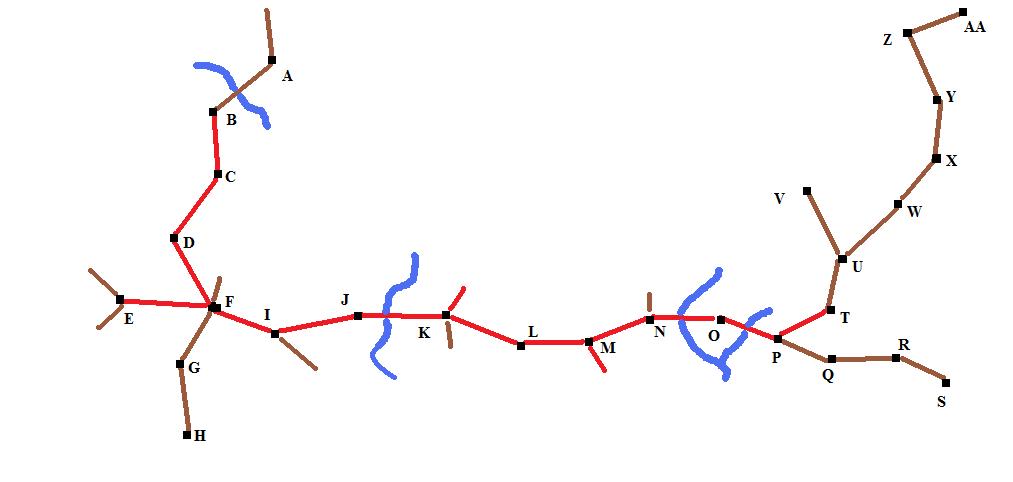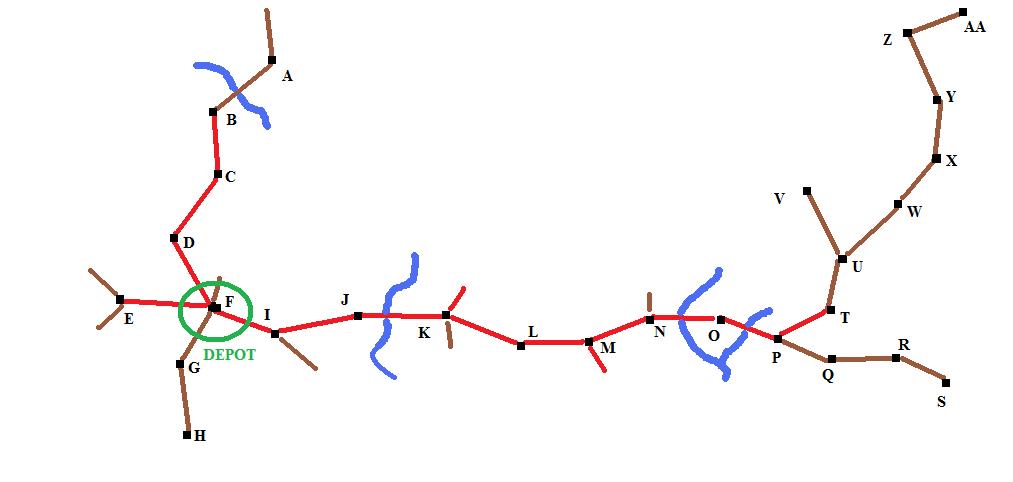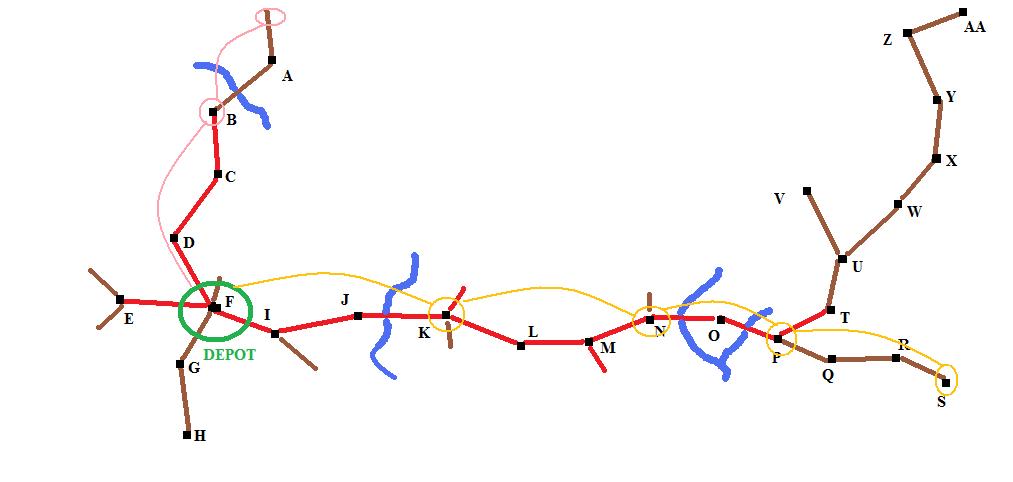CAMPAIGN REFERENCE PAGE
LOGISTICS
| THE RULE OF THREE |
- Couriers and units can find any city within 3 legs of them and
will choose the most direct route available
- Couriers can move into and through contested towns but will not
enter enemy controlled ones
- Units will enter enemy controlled locations and will plan routes
that require them to move through them.
|
- If you want a unit or courier to take a specific route, plan to
order that specific route. Otherwise they will select routes that
seem efficient to them.
- If a city cannot be found within 3 legs and there are no
specific alternate ways to find a destination, units and couriers
will not move.
|
In the picture below, the rule of three would allow a unit at E to find paths
to C,D,F,I,J,G, and H. Note that usually you will be able to specify an
intermediate destination which brings the range for orders up to 6 (eg "I Corps
will move from E to M via J").

| DEPOT |
- All new units (including Corps headquarters) are created at your
active depot
- Replacements are generated at Depots. Each depot may have a
target city designated that new replacements will automatically
begin marching toward. Replacements can be teleported back to one's
depot.
- Lost units can be magically teleported back to one's depot.
|
- May be in any city or fortress in your home nation (including
provinces) or in a port with a neutral sea.
- Depots cost 10 points each
- Each player may have one active depot at any time but may switch
freely
- Depots are destroyed if they come under enemy control
- Depots require 7 days to construct after they are ordered.
|
We will put our depot at the city of F with the notion that our enemy is
somewhere to the east. Since it requires 7 days to construct one, it might be
prudent to keep your active depot always 7 days away from any direct threats.
Prudent but not always possible. To have no depots would mean no new units and
no replacements.

| LINES OF COMMUNICATIONS |
- Often begin at depots but are not required to.
- Allows couriers and replacements to cross long distances.
Couriers within 3 of a LoC can see every other town within 3 of any
node on that LoC.
- There may be 10 nodes on a Line of Communication and each must
be within 3 of a previous node. A line of communication could
stretch from Paris,France to Linz, Austria, for example.
- Couriers can see from a point on one LoC to a point on one LoC
that shares a common node.
|
- If a Line of Communication is broken anywhere along its route by
enemy forces then couriers cannot see past that point to plan
routes.
- Each node on a LoC costs 2 points
- The points selected as nodes may be important because you want
them to cross other LoCs on nodes where possible.
- When couriers travel along a LoC, they move from node to node so
if nodes are closer together, they travel less distance each day.
- Changing LoCs while units are trying to follow them as
previously arranged may confuse units.
|
In the picture below, we construct two Lines of Communication. The Yellow
line will look like F => K => N => P=> S and the pink route will be F => B=> AA
(somewhere north of A). We put the node at P when it could have gone as far as Q
because we intend to push a Corps up the road toward X and Y and this will
enable couriers to start their search for units within 3 from P.
Currently, a message sent from A could now be trusted to find a division at
W. Also, I can now set my replacements to march to P when they are created and 8
days later, any units that I have at P can get some strength back.

| CENTER OF COMMUNICATIONS |
- Each Corps, Wing or Army may have a Center of Communication set
where couriers will go that are looking for the HQ or a Division
belonging to that HQ when they cannot find their target
- Couriers will wait at Centers of Communication until their
recipient can be found.
- If a unit must retreat, they will retreat toward their Center of
Communications where possible.
- A Center of Communication must be a node on a Line of
Communications.
- All the allied players can see the Centers of Communications for
the various HQs on their side. So although Wellington wouldn't know
where Blucher's II Corps is, he would know that its administrative
center of communications was last assigned to be Liege, for example.
|
- As units advance and retreat, it is very easy to not adjust
their Center of Communications to keep up with events.
|
I Corps will set its Center of Communications at P. It is a conceptual anchor
and safety net. The Corps can now roam about north of there knowing that if it
does happen to stray too far form the Line of Communications, any correspondence
for the Corps will be waiting at P until it returned to within 3 legs of it.
In this diagram, if the GHQ wished to send an order to I Corps, couriers
would be unable to make sense of the shorter distance between BB and W via CC.
Instead it must use the Line of Communications that are established and instead
of taking but two days, the couriers will be travelling for 6 days. If the army
intends to operate in this manner for long, they would be well advised, if able,
to throw up a new Line of Communication that looked something like B => BB => CC
=> Y. Note that even if the GHQ moved itself to CC, it still wouldn't be able to
find I Corps (though it could see the division). Lines of Communication are a
vital tool.

Keep in mind that none of this information is neatly displayed on the maps
for you as it is in most games. The information is available in reports and
summaries but you will be required to either keep your communication system
pictured in your head or make and update your own maps.
| NATIONAL ASSETS |
- Depots, Replacements, and Lines of Communications are national
assets. All players of the same nation can use ones made by other
players from their nation. They cannot modify them though.
- It is perhaps reasonable to have a nation's overall commander be
responsible for managing all of the national assets which can
consume a fair number of points, thereby freeing up the others to
concentrate their points into fighting forces.
- Minor allied nations have distinct semi-depots which are always
their national capital. If a player has a line of communication
running through an Allied Minor Nation's Capital then Units and
Replacements can be purchased that will form up in the capital.
Allied Minor Nations can have their replacement march destination
set.
|
- Each nation is responsible for its own Lines of Communications
and Depots.
- If you wish to communicate with an Allied Major Nation through
use of a Line of Communication, you will need to set one up even if
that ally already has one set up running to you.
|




